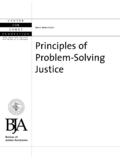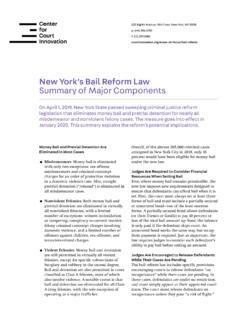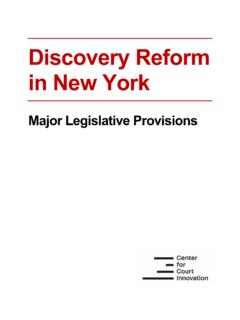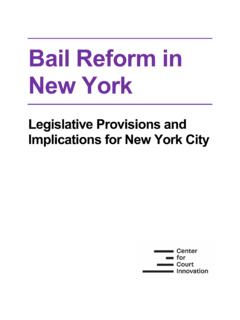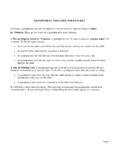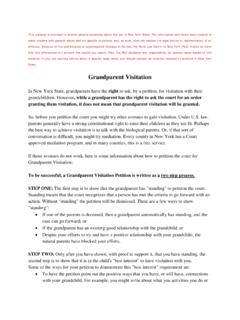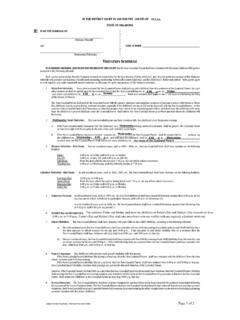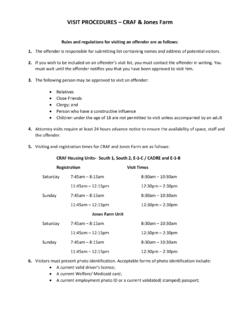Transcription of Supervised Visitation - Center for Court Innovation
1 SupervisedVisitation What Courts Should Know When Working withSupervised Visitation ProgramsBest practicesA Public /Private Partnership with theNew York State Unified Court SystemWritten bySamantha MooreKathryn Ford2006 This publication was supported by the New York State delegation tothe United States Congress through funding provided by the Bureauof Justice Assistance, Office of Justice Programs, Department ofJustice, under Grant No. ww-02-56-26-32. Points of view and opin-ions in this document are those of the authors and do not necessarilyrepresent the official position or policies of the Department separating from their abusive partners, as many as 60 percent of domesticviolence survivors experience ongoing threats and intimidation in connection withissues regarding their recent study indicated that more than onethird of battered women are subjected to severe psychological abuse or threatsduring Visitation and orders of protection can help to ensurethat domestic violence perpetrators have limited access to survivors.
2 Offendersoften use informal Visitation arrangements as an opportunity to continue toassault, harass, stalk and emotionally abuse their partners. In addition, due to thesignificant overlap between domestic violence and child maltreatment, some par-ents may abuse or attempt to abduct their children during visits. When family vio-lence persists in this way, children continue to witness and be adversely affected byit. Because of these risks, courts often find it necessary to require that visitationbetween abusive parents and children is Visitation is contact between a non-custodial parent and his or herchild in the presence of a third party who observes the visit and ensures the child ssafety.
3 In domestic violence cases, visits voluntarily Supervised by friends and fami-ly in their homes can be fraught with danger for the child and victim, as well as themonitor. For this reason, Visitation Supervised by a neutral, professional third party,with the capacity to enforce effective safety measures, is the optimal choice for thecourt. In most communities, these services are provided by social service agencies,such as victim service and child welfare organizations, and can range from one-on-one supervision with a monitor continuously nearby, to visits in large rooms super-vised by several monitors. Although many communities contend with long waitinglists and a limited supply of providers, it remains critical for courts to order agency-based Visitation in cases involving concerns for the safety of the children and/orthe custodial Visitation can be an important tool for avoiding further incidents ofdomestic violence.
4 However, increased safety cannot be guaranteed by simplySUPERVISED Visitation What Courts Should Know When Working WithSupervised Visitation Programs1 Introduction1. Magen, , Conroy, K., McCart Hess, P., Panciera, A. & Levy Simon, B. (1995). Evaluation of a proto-col to identify battered women during investigations of child abuse and neglect. Paper presented at theFourth International Family Violence Research Conference, Durham, , July 22, O'Sullivan, , King, , Levin-Russell, K. & Horowitz, E. (2006). Supervised and unsupervisedaccess in domestic violence cases: Court orders and consequences. Executive summary submitted to theNational Institute of Justice, March Supervised Visitation .
5 Courts must take other measures to ensure the con-tinued appropriateness of the programs they utilize. For instance, courts can makesure that the programs they work with have specialized safety and security meas-ures and staff that is well trained in the dynamics of domestic violence, the impactof this violence on children and the importance of holding batterers accountablefor their actions. In addition, courts can work with local providers to develop for-mal protocols that clearly delineate security and confidentiality procedures, outlinea strategy for maintaining strong relationships between service providers and lawenforcement agencies, and require ongoing staff training on domestic paper highlights a number of practices used by exemplary Supervised visi-tation programs and the courts, and is intended for judges, Court administratorsand their community partners in an effort to reduce the risk of violence for sur-vivors and their children.
6 These recommendations are based upon informationgathered from New York State Supervised Visitation providers, program observa-tions, a review of current literature in the field, and the Supervised VisitationNetwork, a national coalition of providers that disseminates best practice stan-dards. While implementing all of these suggestions may be difficult, this paperaims to give courts and programs a framework for ongoing is much that courts can do to encourage the use of practices that increasevictim safety and offender accountability during Visitation . The following recom-mendations have been developed as a guide for courts working with programs onaddressing the needs of families in and Supervised Visitation program staff should meet regularly and establish aclose working relationship.
7 This will help to ensure that expectations are met onboth sides: that the program understands the Court s needs and concerns and thatthe Court understands the program s issues and experience. The program mustreceive vital information in a timely manner from the Court while providing the courtwith a clear and detailed understanding of their policies and procedures. To maxi-mize safety, providers must also supply the Court with a clear set of criteria regardingappropriate should provide programs with the following information when orderingvisitation: Actual language in the order that mandates the referral to the Supervised visita-tion Center ; The specific services to be provided ( , Supervised Visitation or supervisedexchange); Who may have contact with the children; The duration and frequency of contact; Who will pay for the services.
8 And The type and frequency of reporting about the progress of Visitation that thecourt for Court Innovation2 CommunicationCourt staff should arrange to have a copy of the order of protection and any otherorders that are in effect, as well as any written records of allegations of domestic vio-lence or child abuse, sent to the program. It is vital that these orders are shared withall program staff, that copies are kept on file at the site, and that security officersfamiliarize themselves with the should also ensure that they are receiving reports on a regular basis fromthe program, especially prior to any Court appearances or compliance monitoring.
9 Reports from Supervised Visitation programs should include the following informa-tion: The names of the custodial parent, non-custodial parent and child(ren) and thecase docket number; The name of the person who provided the supervision; The Visitation schedule, including number of visits scheduled and number ofvisits facilitated (specifying date, time and duration of contact); The number of missed visits or times either parent arrived late and an explana-tion of the circumstances; A summary of activities engaged in by the parent and child; and A description of any interventions made during the contact and the reasons,especially if there was an early termination of the is important that staff strive for objectivity and refrain from offering interpreta-tions or recommendations about custody and Visitation in their reports to the partnerships with local law enforcement agencies are crucial to keepingdomestic violence survivors and their children safe during Visitation especiallyshould an emergency situation arise.
10 Some programs have written protocols thatdescribe what responses can be expected from the local police or sheriff's department(including the priority that will be accorded to requests for assistance). If your localprogram does not have such a protocol, contact the Center for Court Innovation a safe and secure physical space is another vital component of super-vised Visitation services. Courts and Visitation sites can develop written protocols thatoutline the following safety measures for referred domestic violence cases: The process of terminating visits when program rules have been violated andsafety is in jeopardy; The procedures for informing all staff, including security officers, of protectiveorders.
